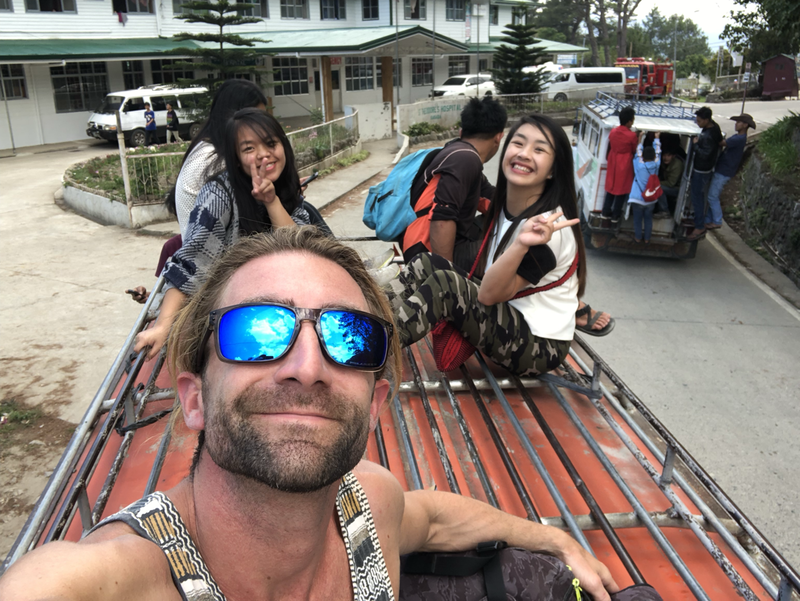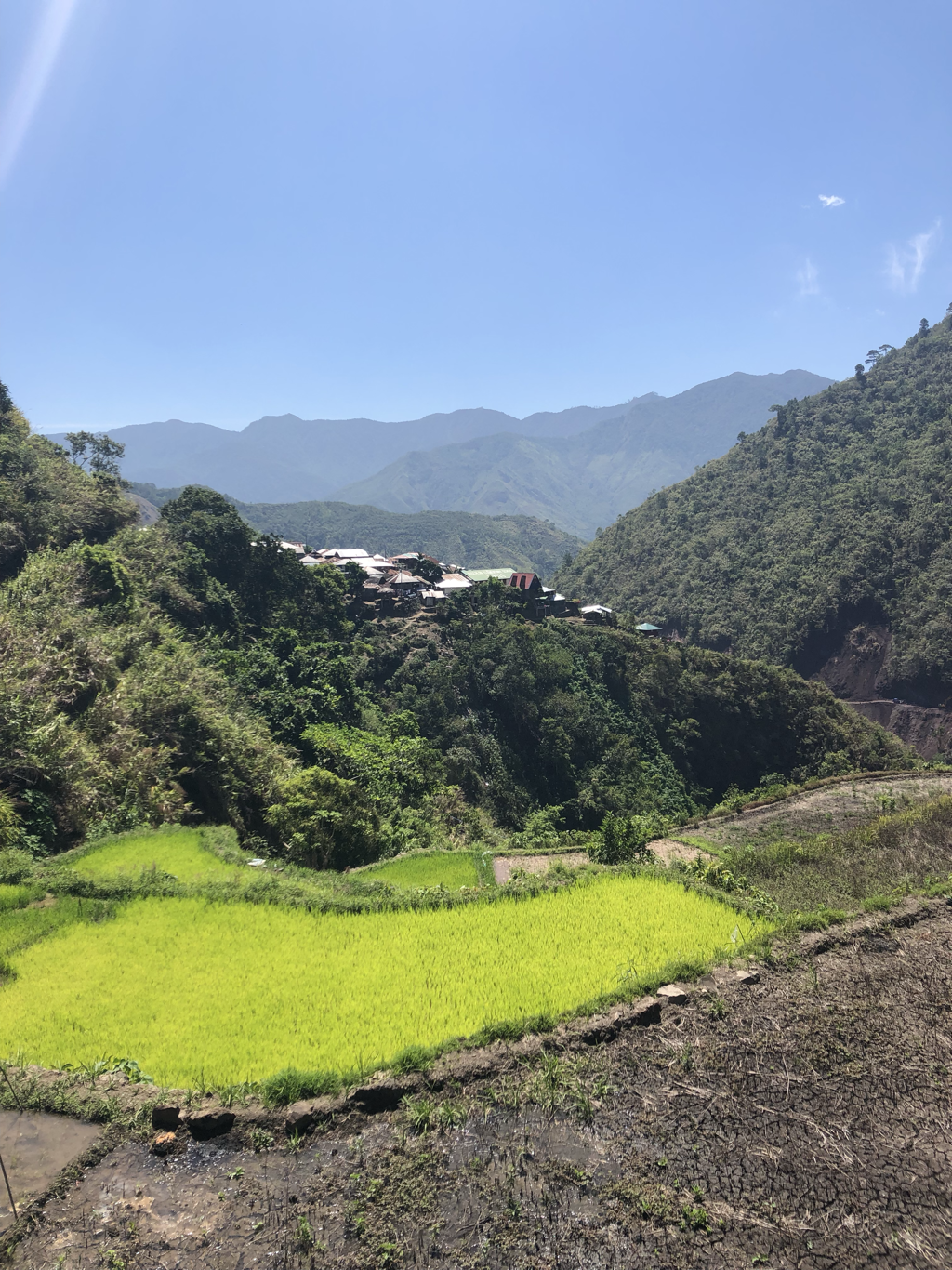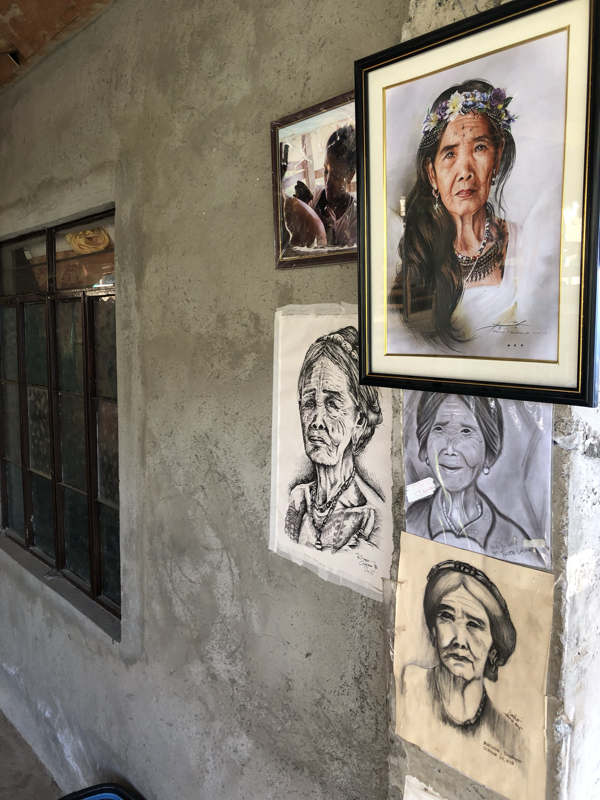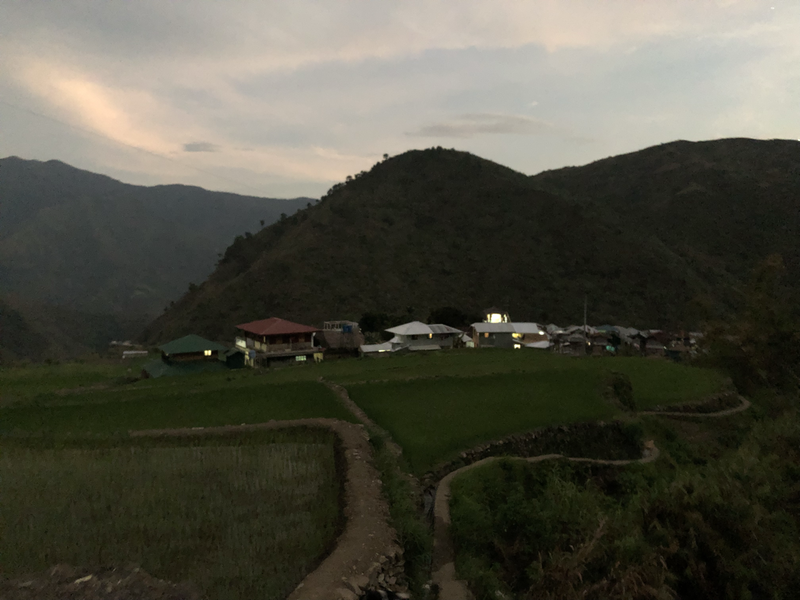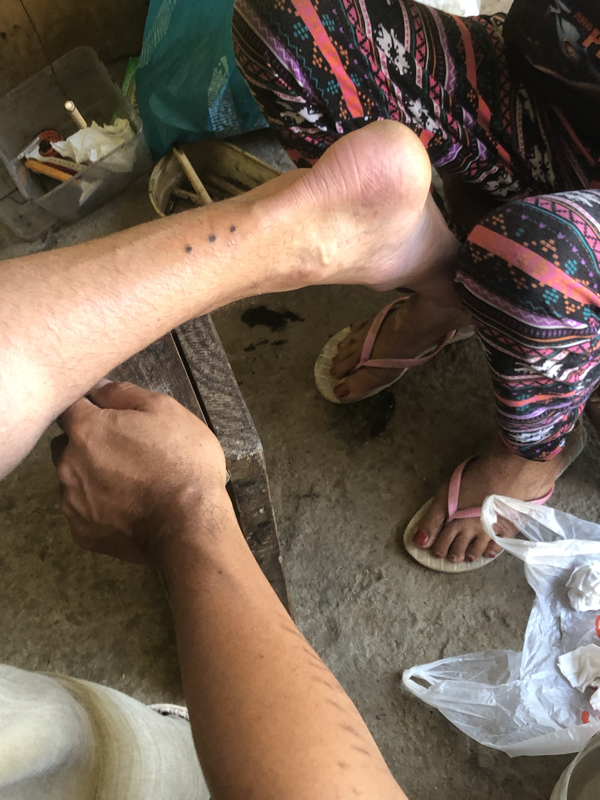|
Showing respect to the 102 year old Whang-od before getting a tattoo from her Meeting the MasterHer eyes are dark and sharp. Her face is timelessly beautiful and earth colored. Deep wrinkles lend her a time worn look, a gnarled tree that has weathered countless storms but still flowers. Tattoos from an era of headhunters and tribal wars adorn her arms, connecting in a graceful swoop across her collarbone. She is a relic, a human treasure, and the last, true Mambabatok. “Deep wrinkles lend her a time worn look, a gnarled tree that has weathered countless storms but still flowers.” At 102 years old, Apo Whang-od Oggay is the world’s oldest tattoo artist. Traditional Kalinga tattooists, known as Mambabatok, were an elite group, consisting of only men with special tattooing ancestry. Whang-od broke the patrimonial mold, becoming the first female Mambabatok in recorded Kalinga history after learning from her father, a master tattooist. Her natural talent evident, the community accepted her and her subsequent decision to train only female apprentices to continue her legacy. A master focuses Due to its remote location and lack of infrastructure, the Philippine government was unable to effectively police large swaths of Northern Luzon to quell tribal conflicts until the end of the 1960s. As such, bloody tribal wars, headhunting, and the associated tattooing continued all the way up until 1972. In the decades from the 70s to the 2000s the Kalinga tattooing heritage began to fall prey to modernization and a lack of interest from younger generations. Fortunately, a rise in indigenous appreciation narrowly averted the art’s total extinction. Whang-od began offering “batok”, hand-tapped tattooing, to members of her native Butbut tribe as well as to others of the larger Kalinga ethnic group when she was just 15 years old. Batok is still carried out the way it was a thousand years ago, with charcoal ink tapped into the skin with a pomelo thorn. Considered beautiful and a status symbol, Kalinga women covered their arms and chests in tattoos. Men, however, earned their tattoos in battle. Male headhunters that successfully returned with an enemy kill were entitled to a corresponding tattoo which Whang-od would ink onto them. Tools of the trade “Batok is still carried out the way it was a thousand years ago, with charcoal ink tapped into the skin with a pomelo thorn.” The beautiful, young Mambabatok fell in love with one of the Butbut warriors that she tattooed after his first battle but fate intervened, dashing hopes of a happy ending. Whang-od made a vow to never take a husband after her star-crossed lover was forbidden from marrying her due to his impure bloodline. Any chances of finding a way around the tribal elder’s wishes vanished when the young man tragically died in a logging accident when she was 25. Although she had relationships with other Kalinga warriors, she stayed true to her vow, never marrying or having children. “Whang-od made a vow to never take a husband after her star-crossed lover was forbidden from marrying her due to his impure bloodline.” According to Kalinga customs, tattooing skills can only be inherited through familial lineage. Whang-od has trained her two grandnieces in the ways of the Mambabatok and today both are traditional tattoo artists in the family’s tribal village. This passing of the torch to the next generation is conveyed in Whang-od’s tattoo signature, three dots, which represents her and her two anointed bloodline successors. However, other batok traditions, such as chanting and fortune telling are no longer practiced and will likely fade away with Whang-od. Buscalan, Northern Luzon Journey to BuscalanTo visit the master, I had to travel to her mountain village of Buscalan, in Northern Luzon. I threw a few things into a day pack and climbed on top of a brightly colored jeepney in Sagada for an exhilarating ride along roads precariously cut into the surrounding mountains. Several hours into the trip it became clear that guardrails and curbs were sparse but rockslides worryingly common. An entire traffic lane was often covered with stones varying in size from a baseball to a college dorm refrigerator. Peering over my legs, which were dangling off the edge of the roof rack, there was often only a few feet between our tires and a sheer drop hundreds of feet to the thundering river below. Riding on the Jeepney roof The road ended abruptly where it literally had yet to be built. Two bulldozers were painstakingly cutting into the hillside to slowly extend modern transportation links to the remote Kalinga and Mountain Province villages perched precariously atop rugged cliffs. Feeling equally grateful for the exciting journey and to be back on solid ground, I clambered down the side of the jeepney to get the last leg of the pilgrimage underway. In the distance, looking down at us from the other side of a deep valley, was unassuming Buscalan. “An entire traffic lane was often covered with stones varying in size from a baseball to a college dorm refrigerator.” View of Buscalan from the surrounding rice terraces The thirty minute hike along the dirt path to the village rivaled the road in the danger department. The narrow ledge cut into the side of the hill was not only susceptible to erosion, there were also clumps of soil that had visibly crumbled under a foot that had stepped too close to the edge. I began morbidly wondering if and when the trail had claimed its last victim. Depending on where you fall it could range from painful and embarrassing to fatal. On the other hand, maybe I’ve just become too accustomed to overly-cautious, western building codes and architecture designed to avoid lawsuits from even the clumsiest of Darwin’s creatures. Stone rice terrace stairs Once we crossed the stream and started the steep, sweaty ascent up the other side of the valley, I began to appreciate the amount of effort that went into bringing supplies to Buscalan. Everything that wasn’t grown or produced there had to be brought in by foot. A woman on the trail was balancing a heavy case of San Miguel beer on her head as she trudged upward and the man in front of her had a 50 pound sack of rice weighing down on his shoulders. Although a beer in Buscalan may be a few extra pesos, it is unquestionably well deserved. Quality time with my homestay family and neighbors The VillageVisitors, even Filipinos, are required to have a local guide when visiting Buscalan. This spreads the benefits of tourism to the community while ensuring that newcomers maintain a low-impact presence and adhere to the Butbut tribal customs. There are no signs for restaurants or lodging, only a few families that open their homes to offer beds and food, making a guide logistically crucial. Although I hadn’t arranged for one ahead of time, Roland, one such guide, was riding on the jeepney roof on his way back from town. I was able to hire him and split his fees with Monika, an equally unprepared Polish backpacker and visiting economics student that I had met en route. Roland’s two young boys greeted us at the trailhead and helped their father carry some household supplies purchased in town. Views in and around Buscalan A local Butbut boy starting his day right Horizontal space in the rugged terrain is hard won, so the village is perched much the way the rice terraces are, with an organically shaped perimeter that mirrors the mountain’s natural contours. High stone retaining walls with a two foot wide walkway on top demand unwavering concentration. Passing others often requires one party to give way by leaning to the inside or even backing up to a wider section. Inside the village the small houses are made from blond pinewood planks and corrugated tin roofs. They are packed in close together, bordered by a labyrinth of paths, occasionally opening up into courtyards filled with squealing children, lounging pigs, and villagers going about their daily routines. Pure mountain streams constantly feed the village with spring water. At one of the communal taps, a woman cleans off dishes while her naked baby splashes about with a good-natured pig greedily cleaning up the scraps. My eyes fluttered open at 5:46am to the sound of woodchopping in the courtyard outside my homestay. My next door neighbor, a hunched over man I guessed to be in Whang-od’s age group, was attempting to split kindling for his breakfast fire. His technique was honed from a century of practice but the power simply wasn’t there any more. Walking down barefoot, rubbing sleep from my eyes, I smiled at him and gestured towards the axe. He nodded and handed it to me. “Pure mountain streams constantly feed the village with spring water.” Not a word was said, nor did it need to be. As I split wood in the cool, dry, morning air, he went to work, slowly sawing longer planks down to length for splitting. A few minutes later several local boys relieved us. He gratefully sat back to watch the industrious young men go to work on the remaining wood and rewarded me with a smile so wide that crows feet nearly connected to dimple lines. Boys help an old man chop wood for his cooking fire The TattooAfter a breakfast of cornmeal pancakes sweetened with mountain honey and local coffee, Roland led me and Monika to Whang-od’s home to get my first and probably only tattoo. My mouth was dry. I was nervous. Not because of the reasons I should have been, like the possibility of infection or the permanence of a tattoo, but because I didn’t know how having someone repeatedly hammering a two inch thorn into my leg might feel. After some consideration I had decided to get her signature three dots vertically up my right achilles. Simple and subtle. Breakfast in the courtyard The three of us plopped down on one of the benches in the shade outside of Whang-od’s home, a few feet from where she was seated on a small, wooden stool tapping a tattoo onto a local Butbut boy of about 12. I silently cursed myself for feeling nervous and stared at my right leg trying to envision what it might soon look like for the rest of my life. When it was my turn I took the master's hand and gently touched it to my forehead, a sign of respect for one’s elders. She smiled warmly as I handed her a bamboo stick with a fresh pomelo thorn and Roland translated my request. With remarkably steady hands and surgical precision she etched the three dots into my skin, a task she had completed countless times before. The entire experience was surreal, one I’ll never forget. Afterall, I have three little dots to remind me. Whang-od's batok signature Follow me on Instagram @restlessben for daily video stories of my adventures.
7 Comments
Greg
4/15/2019 12:12:46 pm
Incredible story, Ben. Whoda thunk Bahrain was the simplest of your adventures! You are truly LIVING your best life. Being able to share in it vicariously is a gem. Thank you!
Reply
Ben
4/15/2019 08:21:14 pm
Greg, as a solo traveler being able to share the adventure with friends and family is especially gratifying. Glad to have you along for the ride!
Reply
Caitlin Snarr
4/24/2019 09:23:55 pm
Although your blog clearly does not suffer from a scarcity of content, I would be interested in a post describing each of the items deemed worthy of real estate in your backpack.
Reply
Ben
4/24/2019 11:46:40 pm
Caitlin,
Reply
3/20/2020 05:49:50 pm
Hello, Ben! You re such a goal! I’ve always been wanting to go there and meet her personally because she is tagged as the oldest mambabatok in the world. Thus, we can consider her as our treasure. I am a huge fan of her tattoos and other artworks that she did especially when she was young, I heard that she no longer make artworks, just her signature trademark. Whatever it may be, I just hope that I’ll get the chance to meet her soon!
Reply
1/23/2024 10:21:30 pm
Oh boy, Jack in the Box, where flavour meets hilarity! Robert O. Peterson sure knew what he was doing when he found this gem of a restaurant. And now, Jack Listens is offering a survey where you can spill the beans about your experience and get rewarded! Head over to https://jacklistenscom.page/survey/, and you could be sinking your teeth into not one but TWO tantalizing Tacos coupons. Talk about a snack attack!
Reply
Leave a Reply. |
AuthorBen quit his job to travel the world. He intends to keep winging it as long as he can. Archives
April 2020
Categories |
 RSS Feed
RSS Feed 



